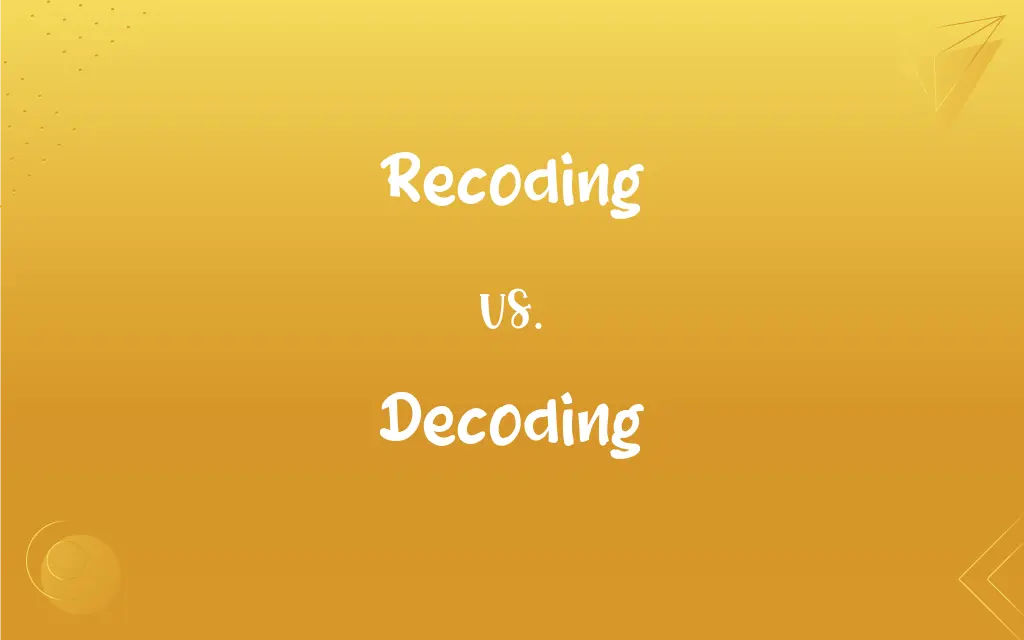Recoding vs. Decoding: What's the Difference?
Edited by Aimie Carlson || By Janet White || Updated on February 5, 2024
Recoding involves changing data from one format to another, while decoding is the process of interpreting or translating encoded information back into its original format.

Key Differences
Recoding and decoding are two processes that often occur in the fields of data processing, communication, and cryptography, each serving a distinct purpose in the handling of information. Recoding refers to the conversion of data or information from one format or code into another, aiming to ensure compatibility across different systems or to simplify the data for analysis. It is a transformative process that alters the form or representation of the data without changing its intrinsic meaning. Decoding, on the other hand, involves interpreting or translating encoded data back into a readable or understandable form. It is a critical step in communication systems, where information is often encoded for transmission and then decoded by the recipient.
Recoding is commonly used in data analysis to categorize or modify data, making it more suitable for statistical analysis or to meet specific research objectives. For example, recoding survey responses from a five-point scale to a simpler agree/disagree format. Decoding plays a vital role in digital communications and cryptography, where information is encoded to secure it from unauthorized access and then decoded by the intended recipient using a specific key or algorithm.
The process of recoding is essential for data interoperability, allowing information to be shared and understood across different platforms, software, or countries. It adapts the data to the requirements of the new system or format, which may involve changing the data structure, compression, or file format. Decoding, in contrast, is crucial for data integrity and confidentiality, ensuring that the information transmitted across networks can be recovered and understood accurately by the intended parties, and is protected against eavesdropping or tampering.
Recoding can also involve the translation of concepts or categories into numerical codes for statistical analysis, making complex qualitative data amenable to quantitative methods. This process does not alter the underlying information but changes how it is represented for specific analytical purposes. Decoding is necessary to revert encoded signals or data to their original forms, enabling the receiver to understand the message or information as it was intended by the sender, whether it's in the context of digital communication, decoding of compressed files, or deciphering encrypted messages.
Recoding and decoding are complementary processes involved in the transformation and interpretation of data. While recoding is aimed at changing the format or representation of data for compatibility or analysis purposes, decoding is focused on translating encoded data back to its original form for understanding or further processing.
ADVERTISEMENT
Comparison Chart
Purpose
To change data format for compatibility or analysis.
To interpret or translate encoded data back to its original format.
Application
Data analysis, interoperability between systems.
Digital communication, cryptography.
Process
Transformation of data representation.
Reverting data to its original, understandable form.
Objective
Simplify data, ensure system compatibility.
Secure transmission, ensure data integrity.
Example
Converting text file formats, recategorizing data.
Decrypting a message, reading a QR code.
ADVERTISEMENT
Recoding and Decoding Definitions
Recoding
Simplifying data representation.
Recoding complex survey answers into binary options streamlined the research process.
Decoding
Reading coded signals.
Decoding the Morse code message saved the stranded sailors.
Recoding
Modifying categories for analysis.
Recoding age groups simplified the demographic analysis.
Decoding
Interpreting data into original form.
Decoding the binary data revealed the hidden message.
Recoding
Changing data format.
Recoding the dataset from XML to JSON improved data handling.
Decoding
Translating encoded information.
Decoding the encrypted email required the correct key.
Recoding
Adapting data for different systems.
Recoding video files ensured compatibility with all platforms.
Decoding
Converting compressed files.
Decoding the ZIP file restored its original documents.
Recoding
Converting codes for interoperability.
Recoding currency symbols facilitated international transactions.
Decoding
Decrypting cryptographic messages.
Decoding the cipher text unveiled the secret communication.
Recoding
Present participle of recode
Decoding
To convert from code into plaintext.
Recoding
The act or result of coding again or differently.
Decoding
To convert from a scrambled electronic signal into an interpretable one.
Recoding
Converting from one code to another
Decoding
To extract the underlying meaning from
Decode a complex literary text.
Decoding
An instance of the translation of something into a form more suitable for subsequent processing.
Decoding
Present participle of decode
Decoding
The activity of making clear or converting from code into plain text;
A secret key or password is required for decryption
FAQs
What does recoding involve?
Changing data from one format or code to another.
How does recoding benefit data analysis?
It simplifies data and makes it suitable for statistical analysis.
In what fields is recoding commonly used?
Data processing, digital media, and statistical analysis.
What is a common application of decoding?
Digital communications and cryptography.
What is the purpose of decoding?
To interpret or translate encoded data back to its original format.
What skills are needed for decoding?
Understanding of the encoding method and sometimes access to decryption keys.
How does recoding affect data storage?
It can optimize data for efficient storage.
Is decoding necessary for encrypted communications?
Yes, to revert the encrypted data to its readable form.
Can recoding change the meaning of data?
No, recoding changes the format, not the intrinsic meaning.
Can recoding improve system interoperability?
Yes, by adapting data to different system requirements.
What role does decoding play in QR codes?
It translates the patterns into information that devices can read.
How does recoding assist in international transactions?
By converting currency symbols and formats for global compatibility.
Is decoding always related to security?
Often, but it also includes reading compressed or coded information.
What challenges are associated with decoding?
Ensuring data integrity and accessing the correct decryption methods.
Can recoding be automated?
Yes, with software tools designed for data conversion.
Why is decoding important in web development?
For processing encoded URLs and data received from web forms.
Can recoding lead to data loss?
If not done carefully, it can result in loss of detail or precision.
How is decoding used in entertainment?
For accessing media encrypted for copyright protection.
What precautions should be taken when recoding sensitive data?
Ensure data integrity and confidentiality are maintained.
How do advancements in technology affect decoding?
They require ongoing updates to decoding algorithms to handle new encryption methods.
About Author
Written by
Janet WhiteJanet White has been an esteemed writer and blogger for Difference Wiki. Holding a Master's degree in Science and Medical Journalism from the prestigious Boston University, she has consistently demonstrated her expertise and passion for her field. When she's not immersed in her work, Janet relishes her time exercising, delving into a good book, and cherishing moments with friends and family.
Edited by
Aimie CarlsonAimie Carlson, holding a master's degree in English literature, is a fervent English language enthusiast. She lends her writing talents to Difference Wiki, a prominent website that specializes in comparisons, offering readers insightful analyses that both captivate and inform.































































